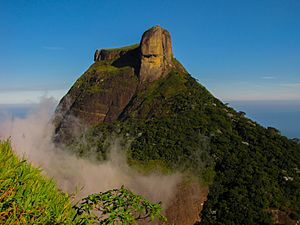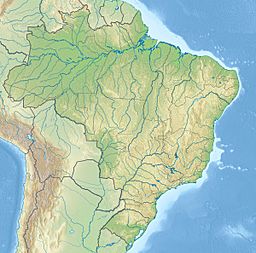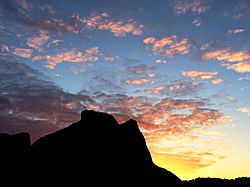Pedra da Gávea facts for kids
Quick facts for kids Pedra da Gávea |
|
|---|---|
 |
|
| Highest point | |
| Elevation | 844 m (2,769 ft) |
| Geography | |
| Parent range | Tijuca |
Pedra da Gávea is a huge, single rock mountain in Tijuca Forest, Rio de Janeiro, Brazil. It is made of strong rocks called granite and gneiss. This mountain is 844 meters (about 2,769 feet) tall. It's one of the tallest mountains in the world that rises straight up from the ocean.
People started making trails on Pedra da Gávea in the early 1800s. Today, this amazing place is part of the Tijuca National Park.
Naming the Mountain
The name Pedra da Gávea means Rock of the Topsail. It got its name during an exploration trip led by Captain Gaspar de Lemos in 1501. On January 1, 1502, sailors on the trip saw the mountain. They thought its shape looked just like a topsail on a ship called a carrack. A topsail is a large sail at the top of a mast.
This mountain was one of the first places in Brazil to be named in Portuguese. The name Gávea was later also given to an area of the city of Rio de Janeiro.
Geology and Nature
Pedra da Gávea is part of the Tijuca mountain range. The very top of the mountain is a flat area made of granite, which is about 150 meters (492 feet) thick. Below this, the mountain is made of gneiss. The granite formed around 450 million years ago, while the gneiss is even older, from about 600 million years ago.
The mountain's unique shapes are caused by something called differential weathering. This means that different types of rock wear away at different speeds. The stronger granite has resisted the weather more than the softer gneiss. This is why the top part looks like a sudden dome. Over time, erosion has also carved interesting marks and shapes into the sides of the mountain.
Many different plants grow on Pedra da Gávea. You can find lemon, orange, breadfruit, banana, and papaya trees. There are also beautiful cannas and roses.
The "Mysterious" Markings
One side of Pedra da Gávea has shapes that some people think look like a human face. On another part of the rock, there are marks that some have claimed are an ancient Phoenician inscription. Phoenician was an old language from the Middle East.
However, most geologists and scientists agree that these "inscriptions" and the "face" are not man-made. They are simply the result of natural erosion over millions of years. The "face" is an example of pareidolia, which is when your brain sees familiar shapes (like faces) in random patterns.
Experts in Brazil, including archaeologists and scholars, have studied the mountain. They agree that Pedra da Gávea is not an archaeological site. In the 1950s, the Brazilian Ministry of Education and Health officially stated that the marks were caused by weather, not by people.
See also
 In Spanish: Pedra da Gávea para niños
In Spanish: Pedra da Gávea para niños



